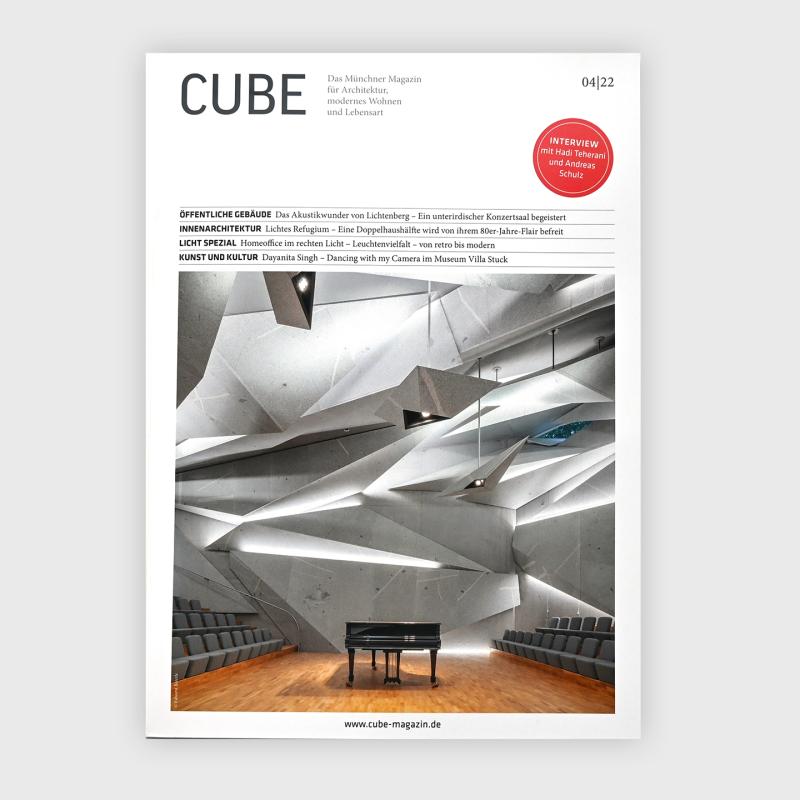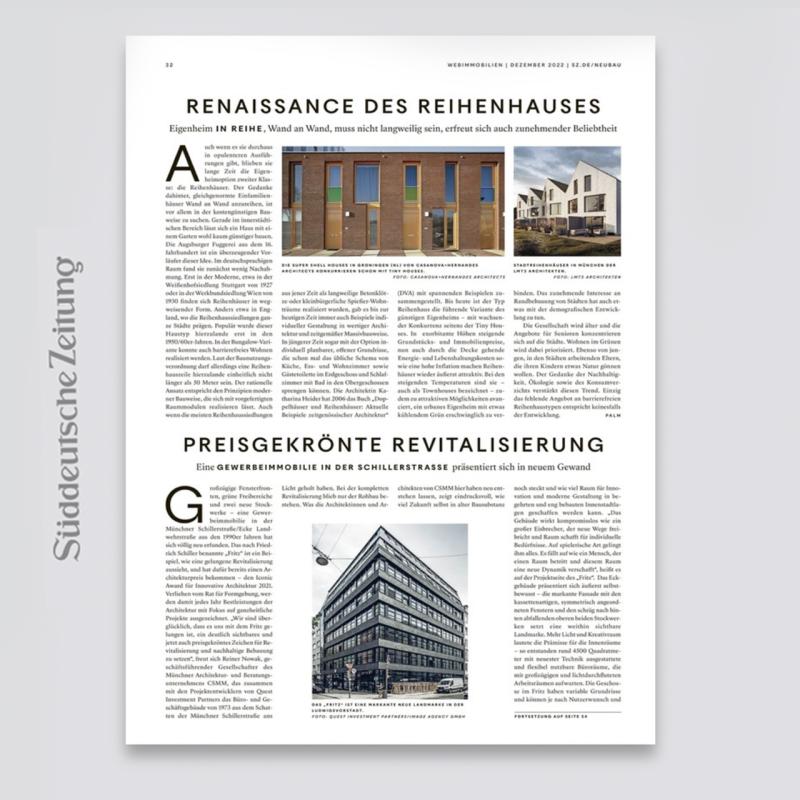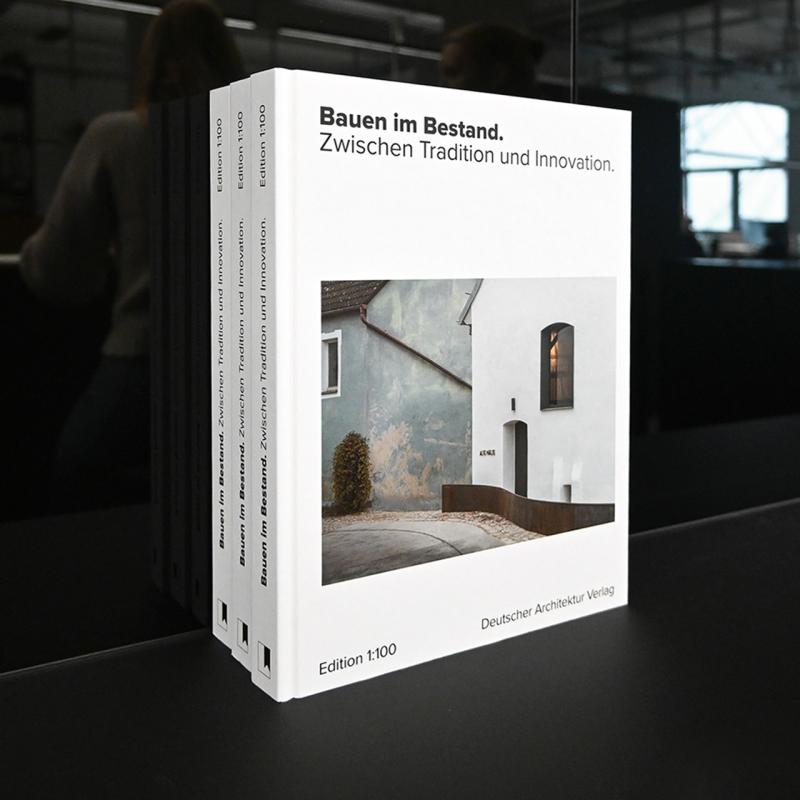Related Content

In the press
CUBE 4/22: Abreissen ist keine Option

In the press
SZ: Award-winning revitalization in Schillerstraße

In the press
Munich, 9 March 2023 – The latest report on emissions published by the German Federal Environment Agency shows that Germany has fallen well short of its climate action targets, and that the use of resources in the construction industry in particular is off the charts. At the same time, commercial buildings and offices are under pressure to prove their sustainable bonafides, even as the focus of modern workplace design shifts to flexibility to accommodate fluctuating numbers of on-site staff and constantly changing demands on the use of space. In celebration of its 20th anniversary, architecture and consulting firm CSMM is speaking out in favour of a visionary approach to design under the banner “Re:build the Future”. The firm’s architects and interior designers have highlighted their six top initiatives for truly effective climate action in the following white paper. Using their sustainable architecture and workplace design projects as a basis, many of which have received prestigious awards, CSMM outlines what it will take to make modern buildings and offices a key catalyst in the transition to a more sustainable future.
1. Renovation, not demolition
The best way to save energy and protect the climate is to maintain and renovate the roughly ten million buildings in Germany’s existing stock. According to the German Federal Statistical Office, roughly 14,090 buildings were torn down in Germany in 2021 – almost 40 buildings per day. This practice of demolishing old buildings and constructing new ones puts a strain on the climate and our resources. To hit our climate neutral target in 2045, we would need to stop all new construction as of 2030. And yet, permitting and approval authorities still do not have a standard set of assessment criteria that factor in the entire lifecycle of a building in both economic and environmental terms. “We should, on principle, evaluate every new development to determine whether the existing structures are worth preserving. Rehabilitation, redevelopment and energy-saving retrofits remain the most effective means of combatting the energy and climate crisis,” says Timo Brehme, Managing Partner at CSMM. In new builds, the structural shell alone accounts for about 40 percent of total construction costs but up to 80 percent of the energy used during construction. That is why placing more emphasis on conserving so-called grey energy is so essential. “It really is worth our while to give existing buildings a new lease of life,” explains Brehme, with a nod to the 1970s-era, downtown Munich office building known as “Fritz”, which the firm renovated and relaunched in 2022. With this widely acclaimed project, CSMM has set the bar high for future revitalisation and sustainable developments based on existing building stock.
2. Smaller per capita footprint
Over the past 70 years, the per capita land use in Germany’s residential sector has more than tripled. There were just 14 square metres of residential space for each citizen in 1950, while that figure has risen to more than 47 square meters today – and the average office space per employee was as high as 40 square meters at its peak. “A smaller footprint means lower energy consumption,” according to Brehme, “and that is an important baseline in the climate action fight. The per capita footprint is already trending down in today’s offices. We help clients find the smartest way to use their space, reducing the overall footprint by up to 50 percent in some cases. That cuts energy costs as well as rent or capital expenditure.” In modern workplaces, desk sharing schemes are already making a big difference in terms of sustainability, while hybrid models that combine working from home with working at the office optimise the use of space and reduce the total area required for each member of staff.
3. Hybrid buildings with 24-hour infrastructure
The sharing approach in the workplace can also be applied to the building as a whole. CSMM likes to think of its developments as hybrid properties that offer shared infrastructure for all occupants – the result is a variety of units with long-term appeal, regardless of who occupies it and how. “The challenge for today’s architects and designers is to create a building shell that can accommodate a variety of uses over time. We like to call this ‘architecture of possibility’, properties that are ideally hybrid by design,” Brehme continues. “We should be able to adapt spaces within our buildings for a variety of uses across all sectors. There is no need to limit ourselves to the needs of a single tenant; instead, we should be pursuing a smart mix of hospitality, hotel, residential and retail units with 24-hour infrastructure.” Innovative developments can provide underground parking, for example, to office workers by day and restaurant guests by night. Another key goal is to give all units access to shared building services, a practice with a lot of potential to conserve energy. “Having a single HVAC system for all units means centralis ed management of the supply from day into night,” Timo Brehme explains. For CSMM, achieving the most energy-efficient use of space is a vital step toward protecting the climate.
4. Room-in-room systems outperform permanent installations
To design commercial spaces with maximum efficiency and flexibility that are suitable for every possible occupant, it is important to think of the tenant as separate from the architecture and infrastructure. The idea that tonnes of perfectly good furnishings and fixtures are landfilled every time a new tenant moves in is a waste of resources and energy that should concern us all. Room-in-room concepts offer a more efficient use of resources and space, even where there is high fluctuation in the number of on-site staff. The more flexible and location-independent companies are – and the more space they need to grow – the greater the benefits of modular furnishings and fittings that can quickly, cost-effectively and easily be adapted to each new office layout. “We have had great success with room-in-room solutions in several of our workplace designs,” explains Timo Brehme, “but without sacrificing our clients’ brand style or their instantly recognisable corporate design.”
5. Using recyclable, sustainably produced materials
When it comes to workplace design, the circular economy approach is key, i.e., using products and materials that can be separated and recycled at the end of their useful life. Composite materials are an environmental disaster, because it is impossible – or else very costly – to separate a complex mix of materials for recycling. Even the manufacturing process is inextricably linked to the use of precious resources. Goods and raw materials have a massive impact on carbon footprint in the many processes required to transport, extract and refine them. Timo Brehme sees one possible remedy: “We should have access to material databases that provide key environmental indicators on various manufactured goods. With reliable data on, for example, the amount of non-renewable primary energy used, the global warming potential or the acidification impact on land and water, it would be easy to identify products that are actually environmentally friendly.” Another important step toward a climate-neutral future could be to lease products instead of buying them. If manufacturers were able to take certain products back and reuse them elsewhere, it would mean an urgently needed step in the right direction and a positive contribution to the eco-balance.
6. Buildings as a warehouse for building materials
It has long been clear to most stakeholders that the best way to save energy in construction is to take a cradle-to-cradle approach. Separating building materials by type and repurposing them instead of throwing them away should be the norm across the sector. This would not only reduce energy use significantly, but also the overall consumption of valuable resources. Using circular economy strategies and choosing construction materials and methods that focus on the entire lifecycle are the single-most effective factors in our fight against climate change. Statistics show that this can reduce CO2 emissions by up to 25 percent both during construction and in the energy use of the completed building. Having online construction material exchanges and databases with reliable information on the energy required for disassembly and the availability of recycling options for each material would be an important step. “We should think of the existing building stock as a warehouse for future building materials,” Timo Brehme stresses. “Scrap material that accumulates during disassembly should be earmarked for use elsewhere, perhaps in a new build. Mineral-based construction materials like concrete or bricks, for example, can be virtually 100% recycled and repurposed. In the design process for any new build, our state-of-the-art BIM systems can provide reliable estimates on avoiding waste, recycling materials and optimising the lifecycle assessment.” The European Commission is also rising to the challenge with the European Green Deal (ESG). Thanks to the EU Taxonomy legislation, Europe is well on its way to becoming a modern, resource-efficient and climate target-compliant economy. “The more we incentivise new opportunities in sustainable architectural design,” says Timo Brehme, “the greater the demand for taxonomy-compliant properties in the future.”
Media contact
hicklvesting
Contact: Nicole Vesting
Kurfürstenplatz 6, 80796 München
Tel: +49 (0)89 45 23 508-11
Fax: +49 (0)89 45 23 508-20
E-Mail: nicole.vesting@hicklvesting.com
CSMM – architecture matters
Contact: Nina Eisenbrand
Werk 3, Atelierstraße 14, 81671 München
Tel.: +49 (0)89 960 15 99-0
Fax: +49 (0)89 960 15 99-99
E-Mail: marketing@cs-mm.com